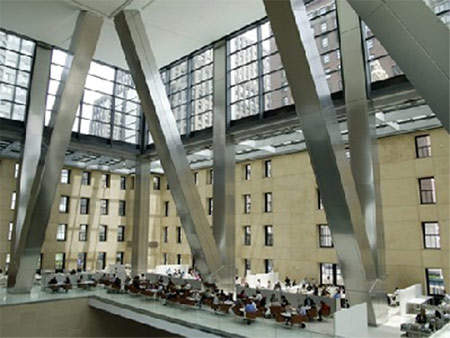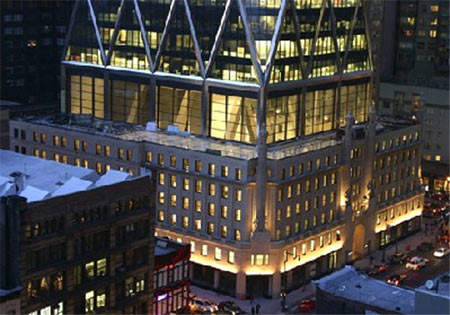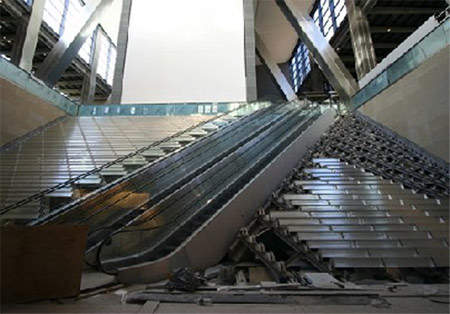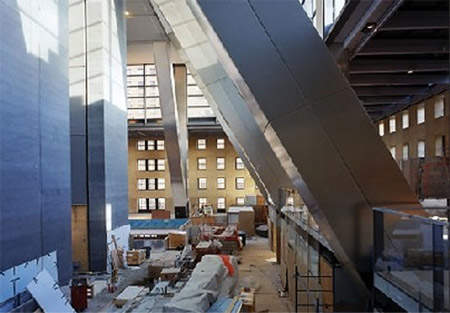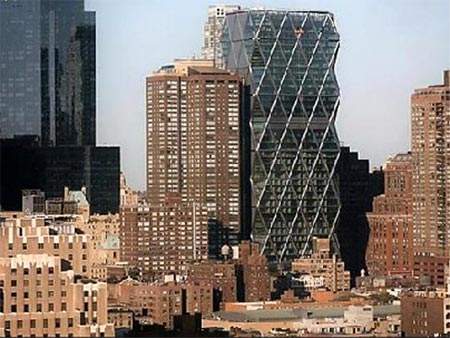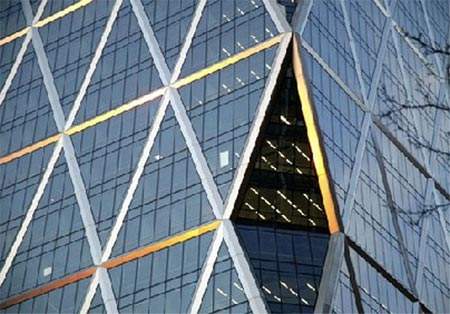The Hearst Tower has finally become a reality after being first planned over 75 years ago. The building, which is New York’s newest sky scraper, opened in October 2006 after three years of construction (plans were made in 2001).
The tower was designed by Sir Norman Foster of Foster and Partners in London and is his first building in New York. Gensler worked with Foster and Partners to incorporate green design and construction features to create an energy-conserving office environment for 2,000 Hearst employees.
The 46-storey, 856,000ft² tower on Eighth Avenue between 56th and 57th Streets, with its distinctive triangular frame also has the distinction of being New York’s first Gold LEED (Leadership in Energy and Environmental Design) certified building. The design of the $500m midtown structure is defined by the use of vertical and horizontal energy-saving, diamond-shaped bands of bright stainless steel on its outside.
The tower actually occupies the shell of the original six-storey Hearst edifice, designed by Joseph Urban and George B Post & Sons and built in 1928 (cost $2m). This reinforced structure, which was called the International Magazine Building, was designed to bear an office tower, but this was originally cancelled because of the onset of the great depression.
Design features
Gensler, along with Foster and Partners, were able to put forward a sustainable design for the glass and steel triangular Hearst Tower, which rises 597ft (182m) from the original 40,000ft² plinth of the original building, signifying a link between old and new.
The L-shaped, pre-cast, tan limestone façade from the original building with retro columns, balustrades, sculptures, spandrels, and windows was preserved and restored. Its facade, a two-storey base with four storeys set back, now wraps around as a pediment for the new tower. The Hearst Tower is designed to be 26% more energy-efficient than a standard office building.
Diagrid design
The exterior of the new tower is dominated by a ‘diagrid’ design; the exterior is a series of four-storey, peeled-back steel triangles on a facade of sloping floor-to-ceiling glass, allowing the office and plaza areas to be flooded with natural light.
In addition, its frame eliminates the need for 2,000t of steel that a conventional frame would employ. The steel framework is visible both inside the building and on the street. The Diagrid (a contraction of ‘diagonal grid’) consists of four-storey grade-65 steel triangles prefabricated by the Cives Steel Co at two plants, one in Gouverneur, NY, and the other in Winchester, Va. 90% of the steel is recycled, which includes the interior diagonal columns and braces behind the facade in the tower’s ten-storey atrium.
The tower has a triangulated form with its corners peeled back, the effect emphasises the building’s vertical proportions and creates a distinctive faceted silhouette on the New York skyline. The tower is linked to the existing building by a transparent skirt of glass which floods the spaces below with natural light, giving the impression of a glass tower floating weightlessly above.
Energy saving features
Energy-saving features in the tower include:
- Glass coating to reduce solar radiation and therefore cooling load – the glass has a special ‘low-E’ coating that allows for internal spaces to be flooded with natural light while keeping out the invisible solar radiation that
causes heat - A limestone atrium floor with embedded polyethylene tubing for circulating water for cooling in the summer and heating in the winter
- Sensors that control artificial light based on the amount of natural
light - Motion sensors to turn off lights and computers when an area is
unoccupied - High-efficiency heating and air-conditioning equipment that uses outside
air for cooling and ventilation for 75% of the year - A roof that collects rainwater in a 14,000gal basement reclamation tank, which then replaces water lost to evaporation in the office air-conditioning system and feeds into a pumping system to irrigate plantings and trees inside and outside of the building
- The ‘Icefall,’ a two-storey waterfall that chills the ten-storey atrium, drawing off warm-season heat using rainwater from the roof
- Few internal walls and low workstation partitions to maximise natural light
- Walls are coated with low-vapour paints
- Low-toxicity furniture, finishes and carpeting have content that is
recycled or harvested from sustainable forests - Concrete surfaces are treated with low-toxicity sealants
Social heart of the Hearst community
The main space of the Hearst Tower is the grand internal plaza that occupies the entire shell of the historic base. Inside this is a dramatic ten-storey atrium and café space surrounded by the original windowed masonry facade.
Older Hearst employees have voiced a feeling of connection with the new facility because they can actually see the windows of their old offices intact in the old masonry shell. The space has been called “the social heart of the Hearst community”. A series of diagonal escalators set amid the waterfall connects the street level to the plaza.
Tower facilities
The tower has been designed with a full complement of modern technologies (such as WiFi from Cisco Systems with 288 thin access points) and an open work place layout that emphasises increased communication and collaboration.
In addition to the magazine and corporate offices, there is also an ultra-modern broadcast studio, a digital photography centre, a first-class fitness centre (the CLUB) open to employees at subsidised prices, an executive conference and dining centre (The 44th Floor), a 340-seat corporate cafe (Café 57), a 168-seat theatre (Joseph Urban Theatre), exhibition spaces and a ‘Good Housekeeping’ Research Institute, housing a wide range of
facilities and equipment to test virtually every consumer product in America, as well as the fabled Good Housekeeping Dining Room.
The interior fitments
A series of diagonal escalators set between a cascading waterfall of chilled water connects the street level to the grand internal plaza, with elevated mezzanine levels used for meetings, exhibitions and special functions.
The two-storey-high ‘Icefall’– a collaboration of Foster and Partners with glass specialist Jamie Carpenter and Jim Garland of Fluidity – uses collected rainwater to cool the atrium in summer and humidify it in wintertime.
‘Riverlines’, a 40ft × 70ft installation by artist Richard Long, is a rich, contemplative mural set against the elegant grey stone of the elevator core. Resembling a type of Stone Age cave painting for the 21st century, it is created from the mud of the Avon and Hudson rivers and celebrates the metaphor of the river as a symbol of journey, movement and life.
Contractors
Tishman Speyer was the project manager and the owner’s developer; Foster and Partners were the design architects; Turner Construction was responsible for construction management; Adamson Associates were the associate architects; Gensler were the interior architects; WSP Cantor Seinuk were the structural engineers; and Flack and Kurtz were the mechanical engineers.
Cives fabricated and supplied the structural steel (10,480t of steel used). VDA supplied and installed the 15 passenger elevators. Lighting systems were installed by George Sexton. Food Service is provided by Ira Beer. Other companies involved in the construction included Van Deusen & Associates (New York), Link-Belt Construction Equipment Company, Permasteelisa USA,
Cornell & Company Inc (steel erector).
Subway improvements
Hearst Communication Inc, the owners of the tower, is complying with the American’s With Disability Act (ADA) and making improvements over pedestrian traffic flow at Columbus Circle Station as part of their overall construction of the new headquarters (Tower) project. Hearst started the improvements in January 2004 with final completion in the third quarter of 2005. The Hearst
improvements included:
- Three new ADA-compliant elevators (mezzanine to platform)
- Two new stairs (mezzanine to platform)
- Four reconfigured stairs – widened and reoriented (mezzanine to platform)
- Two refurbished stairs to street level through the new Hearst Building
- Relocated fare stations for better accessibility and traffic flow
These improvements, coupled with an existing elevator to street level, and other New York City Transit work, now provide better access to the station for persons with disabilities. Columbus Circle Station is the 14th busiest station (out of over 400) in the New York City Transit System.

